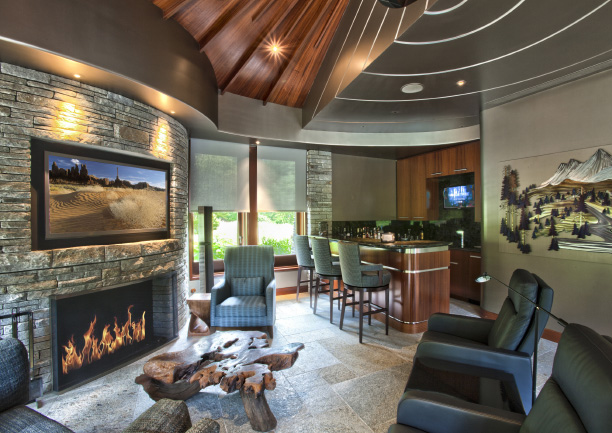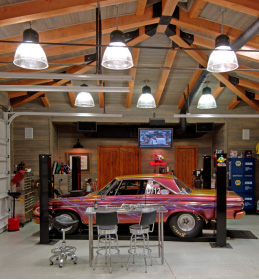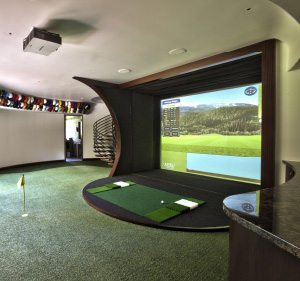By David M. Brown
A woman needs a home, a man his garage.
One automotive enthusiast with a superlative collection of vehicles once told me that when he is in the connubial doghouse, his wife banishes him to the garage to retune his ways. So, he retires to his climate-controlled grotto to do hairshirt penance amidst cars and Coronas. He loves it.
When you build your man cave, in addition to considering a billiards table, bar, media room, a showroom of vintage cars or just that one collectible you spent a thousand hours and thousands more than it was worth to rebuild better than new, consider building it green too. The extra effort will cost more upfront but the return will come in overall energy savings.
“The successful man cave provides a specific design atmosphere and represents a reflection of the ‘master’s personality,’” says Jon Bernhard, AIA, a partner in the distinguished Scottsdale-based architectural firm, Swaback Partners, founded 36 years ago by Vern Swaback, FAIA, one of Frank Lloyd Wright’s last apprentices.
“This atmosphere might be a club/ lounge environment, sports/recreation, memorabilia, motor-head, health/fitness, security/cocoon, eco-friendly or just something unique and way cool.”
Green Path to the Garage
Consider the full menu of sustainable design options such as window treatments, heating and cooling innovations and upgraded insulation.
These might include a subgrade space such as a basement, which can provide a secure, isolated atmosphere protected from temperature extremes. “This might appeal to the zombie apocalypse type,” Bernhard says, with a smile.
If you’re considering an aboveground space, orient it in response to the regional climate to maximize passive use of natural resources, such as abundant daylight and cross-breeze ventilation, he adds. 
Avoid, if possible, exposure of the garage door or extensive window space to the afternoon sun. If that is unavoidable, you can insulate the panels of the steel garage door with fiberglass. Kits are widely available at Lowe’s, Home Depot and hardware stores.
Probably the most cost-effective element to making a garage, or any other space, more energy-efficient and sustainable is good insulation, says Mark B. Candelaria, AIA, principal of Candelaria Design Associates, LLC, of Phoenix and Coeur d’Alene, Idaho.
Insulation can be standard fiberglass batting, which rolls into the walls and lies between ceiling rafters, or sprayed-in foam; the most beneficial product available but also a good deal more expensive.
“We have constructed above-ground garages or man caves that were well insulated and, even without mechanical cooling systems, they stay comfortable even with our Arizona heat,” says Candelaria, whose 15-year-old firm specializes in custom residential projects, new, remodel and renovation, and boutique commercial projects.
Sound insulation is also important. Require sound insulation such as spray foam or cellulose in perimeter walls, sound absorption panels on lateral walls and sound deflection on the screen, or front, wall to project sound, suggests Scottsdale architect, Nick Tsontakis, AIA, NCARB. Varying the ceiling design will enhance the sound, he adds.
If you are going to incorporate windows, use well-insulated dual-pane low-e windows, Candelaria explains, noting that he prefers the metal-clad wood windows that are almost maintenance-free rather than the once-popular aluminum windows which absorb more heat.
You can add light insulation with motorized black-out screens, Tsontakis adds.
Even Without Pocket Green, Think Sustainable
For the budget-conscious, be innovative with the space you have, Bernhard suggests. Minimize landfill waste by repurposing existing under-utilized space rather than demolishing and rebuilding. And, combine indoor with outdoor areas, integrating movable wall panels and extended roof lines to create a usable floor area that can expand well in excess of the constructed floor area. In this way, the additional space does not entail additional heating and cooling costs.
Build with readily available resources, such as scrap lumber, overstock merchandise, local products and, where applicable, materials found on or near the site, he adds. For one garage, Candelaria recently incorporated a reclaimed wood ceiling and wall siding, an insulated sandwich roof and wall system, energy-efficient lighting and, of course, a reclaimed car.
“Integrating reusable and/or recycled materials –– ‘cradle-to-cradle’ methods and materials –– applied thoughtfully, can save cost, minimize waste and make a design statement,” Bernhard says. 
“I love the LED lighting product, Candelaria says. “They last forever, use low amounts of power and radiate very little heat: all positives.” He adds that, although energy-efficient, LED lights are still expensive initially but their longevity more than makes up for the cost.
For those with larger budgets, solar panels are an excellent way to reduce power needs. With federal and state incentives, they still require a $13,000 or so investment for an average-size home. “The payback on most of these systems is still 6 to 7 years [others say 8 to 9], but it makes sense if you are in for the long haul,” Candelaria says.
Some of the new cooling and heating systems, such as the natural gas versions, are extremely energy-efficient, Candelaria says. Unlike conventional systems, these rely on a gas heat pump unit tied into multi-zoned ducted and ductless air handlers through refrigerant lines; the typical decorative grilles and linear slot diffusers are used. The refrigerant lines can run up to 690 feet, which greatly reduces the amount of ductwork necessary. “The upfront cost for equipment is higher than conventional systems, but there are major construction and long-term energy savings,” Candelaria says.
So, when you retire to, or are banished to, your grotto/garage, everyone will be proud.
Photos courtesy Swaback Partners and Candelaria Design Associates







Great! Thank you for your comment!